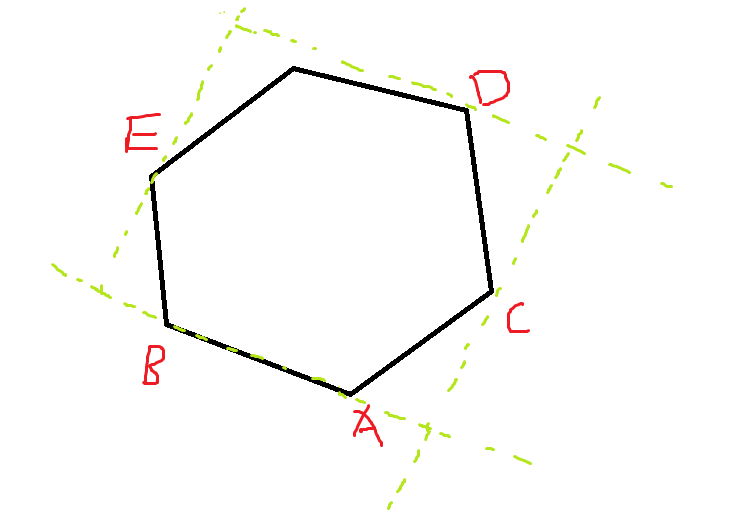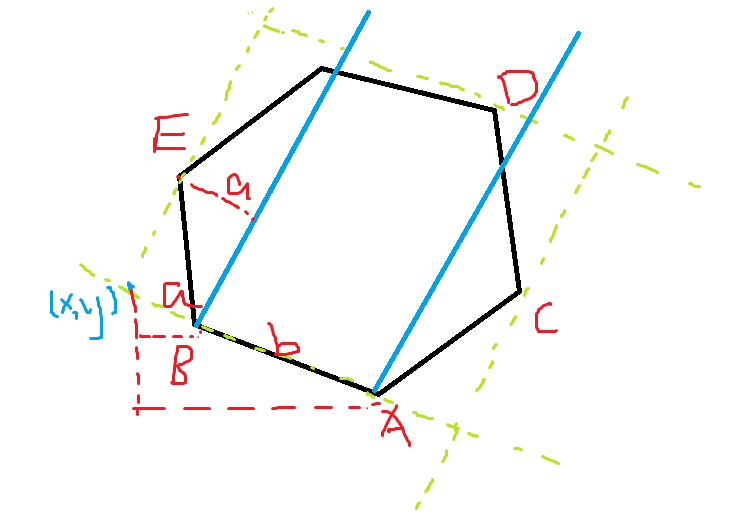[HNOI2007]最小矩形覆盖
题目描述
给定一些点的坐标,要求求能够覆盖所有点的最小面积的矩形,输出所求矩形的面积和四个顶点坐标
输入输出格式
输入格式:
第一行为一个整数n(3<=n<=50000),从第2至第n+1行每行有两个浮点数,表示一个顶点的x和y坐标,不用科学计数法
输出格式:
第一行为一个浮点数,表示所求矩形的面积(精确到小数点后5位),接下来4行每行表示一个顶点坐标,要求第一行为y坐标最小的顶点,其后按逆时针输出顶点坐标.如果用相同y坐标,先输出最小x坐标的顶点
题解
题目简单易懂。做法扑朔迷离。
首先,矩形的一个边一定和凸包的一条边重合(???貌似无人会证???dalao说显然,juruo说是结论??)。
然后可以旋转卡壳
我们需要固定这样几个点:A/B/C/D/E
D是最高点,A,B是枚举的边,C、E是左右最远点。

D直接旋转卡壳可以找到。
C,E满足位置转动单调性。
对于C,只要判断,BA向量和AC向量夹角是锐角,
对于E,只要判断,BA向量和BE向量夹角是钝角。
在此基础上,C,E不断移动到不行为止。
锐角钝角可以用点积正负判断。
算面积的话,高好说,就是D到AB的距离。
宽的话,是AB+(C在AB上的投影长度)+(E在AB上的投影长度)
投影长度可以用点积计算。
然后,矩形四个点怎么算??
参考ywy大神方法:用相似三角形。
题解 P3187 【[HNOI2007]最小矩形覆盖】

a就是投影。叉积计算即可。
其他三个点同理。
完毕。
(PS:这个题貌似就只有一个矩形满足面积最小,,,,我也不知道为什么。。。)
(但是我还是对每个矩形都求了一下四个点,然后判断的)
#include<bits/stdc++.h> #define reg register int #define il inline #define numb (ch^'0') using namespace std; typedef long long ll; il void rd(int &x){ char ch;x=0;bool fl=false; while(!isdigit(ch=getchar()))(ch=='-')&&(fl=true); for(x=numb;isdigit(ch=getchar());x=x*10+numb); (fl==true)&&(x=-x); } namespace Miracle{ const int N=50000+5; const double eps=1e-10; const double inf=1123333333.01; int n; struct po{ double x,y; po(){} po(double xx,double yy){ x=xx;y=yy; } po friend operator +(po a,po b){ return po(a.x+b.x,a.y+b.y); } po friend operator -(po a,po b){ return po(a.x-b.x,a.y-b.y); } bool friend operator <(po a,po b){ if(a.y!=b.y) return a.y<b.y; return a.x<b.x; } }a[N]; set<po>s; struct vec{ double x,y; vec(){} vec(po a){ x=a.x,y=a.y; } double len(){ return sqrt(x*x+y*y); } }; double dis(po a,po b){ return sqrt((a.x-b.x)*(a.x-b.x)+(a.y-b.y)*(a.y-b.y)); } double cross(vec a,vec b){ return a.x*b.y-a.y*b.x; } double dot(vec a,vec b){ return a.x*b.x+a.y*b.y; } int Fabs(double t){ if(fabs(t)<eps) return 0; if(t>0) return 1; return -1; } double hei(po p,po a,po b){ vec t1=vec(a-b),t2=vec(p-b); return fabs(cross(t1,t2))/dis(a,b); } bool cmp(po x,po y){ double t=cross(vec(x-a[1]),vec(y-a[1])); if(Fabs(t)) return t>0; return vec(x-a[1]).len()<vec(y-a[1]).len(); } po sta[N]; int top; double ans; int mem[10]; po op[10]; po tmp[10]; int m; int main(){ scanf("%d",&m); ans=inf; double x,y; for(reg i=1;i<=m;++i){ scanf("%lf%lf",&x,&y); if(s.find(po(x,y))==s.end()){ //cout<<" new "<<x<<" "<<y<<endl; s.insert(po(x,y)); a[++n]=po(x,y); } }int id=1; for(reg i=2;i<=n;++i){ if(a[i].x<a[id].x||((a[i].x==a[id].x)&&(a[i].y<a[id].y))) id=i; } if(id!=1) swap(a[1],a[id]); sort(a+2,a+n+1,cmp); sta[++top]=a[1]; for(reg i=2;i<=n;++i){ while(top>2&&cross(vec(sta[top]-sta[top-1]),vec(a[i]-sta[top]))<0) --top; sta[++top]=a[i]; } // cout<<" top "<<top<<endl; // for(reg i=1;i<=top;++i){ // cout<<" ii "<<i<<" : "<<sta[i].x<<" "<<sta[i].y<<endl; // } int A,B,C,D,E; A=1,C=1,B=top,E=top;D=1; while(Fabs(dot(vec(sta[E-1]-sta[E]),vec(sta[A]-sta[B])))<=0) --E; //n=233333; for(reg A=1;A<=top;++A){//i&&i-1 B=A-1;if(B==0) B=top; //if(sta[A]==sta[B]) continue; while(Fabs(dot(vec(sta[C%top+1]-sta[C]),vec(sta[A]-sta[B])))>=0) { C=C%top+1; //cout<<" CCC "<<C<<" : "<<dot(vec(sta[C]-sta[A]),vec(sta[A]-sta[B]))<<endl; } while(Fabs(dot(vec(sta[E]-sta[E%top+1]),vec(sta[A]-sta[B])))>0) E=E%top+1; while(Fabs(fabs(cross(vec(sta[D%top+1]-sta[B]),vec(sta[A]-sta[B])))>fabs(cross(vec(sta[D]-sta[B]),vec(sta[A]-sta[B]))))) D=D%top+1; double H=hei(sta[D],sta[A],sta[B]); double d=dis(sta[A],sta[B]); double L=d+fabs(dot(vec(sta[E]-sta[B]),vec(sta[A]-sta[B]))/d)+fabs(dot(vec(sta[C]-sta[A]),vec(sta[A]-sta[B]))/d); //cout<<" A "<<A<<" B "<<B<<" C "<<C<<" D "<<D<<" E "<<E<<" : S "<<H*L<<endl; double bb=dis(sta[A],sta[B]); double aa=fabs(dot(vec(sta[E]-sta[B]),vec(sta[B]-sta[A]))/bb); op[1]=po(sta[B].x-aa*(sta[A].x-sta[B].x)/bb,sta[B].y+aa*(sta[B].y-sta[A].y)/bb); double cc=fabs(dot(vec(sta[C]-sta[A]),vec(sta[A]-sta[B]))/bb); op[2]=po(sta[A].x+cc*(sta[A].x-sta[B].x)/bb,sta[A].y-cc*(sta[B].y-sta[A].y)/bb); H=hei(sta[D],sta[A],sta[B]); double tt=dis(op[2],sta[C]); op[3]=po(op[2].x+H*(sta[C].x-op[2].x)/tt,op[2].y+H*(sta[C].y-op[2].y)/tt); double ee=dis(op[1],sta[E]); op[4]=po(op[1].x+H*(sta[E].x-op[1].x)/ee,op[1].y+H*(sta[E].y-op[1].y)/ee); id=1; for(reg i=2;i<=4;++i){ if(op[i].y<op[id].y||((op[i].y==op[id].y)&&(op[i].x<op[id].x))) id=i; } if(Fabs(ans-H*L)>0||(Fabs(ans-H*L)==0&&op[id]<tmp[1])){ ans=H*L; for(reg i=1;i<=4;++i){ tmp[i]=op[id]; id=id%4+1; } } } printf("%.5lf\n",ans); for(reg i=1;i<=4;++i){ if(Fabs(tmp[i].x)==0) tmp[i].x=0.00; if(Fabs(tmp[i].y)==0) tmp[i].y=0.00; printf("%.5lf %.5lf\n",tmp[i].x,tmp[i].y); } return 0; } } int main(){ Miracle::main(); return 0; } /* Author: *Miracle* Date: 2018/11/24 18:49:07 */


 浙公网安备 33010602011771号
浙公网安备 33010602011771号